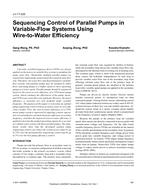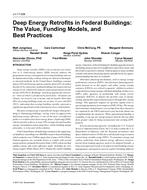-
-
Available Formats
- Options
- Availability
- Priced From ( in USD )
-
Available Formats
-
- Immediate download
- $16.00
- Add to Cart
Customers Who Bought This Also Bought
-

LV-17-025 -- Sequencing Control of Parallel Pumps in Vari...
Priced From $16.00 -

LV-17-008 -- Determination of Solar Heat Gain Coefficient...
Priced From $16.00 -

LV-17-007 -- Determination of Heat Transfer Coefficient B...
Priced From $16.00 -

LV-17-006 -- Deep Energy Retrofits in Federal Buildings: ...
Priced From $16.00
About This Item
Full Description
Energy consumed by buildings accounts for about 30% -40% of the total energy consumption. In buildings, heat lossthrough windows accounts for 20%-40% of cooling and heatingloads. In this work, airtightness of sliding and lift sliding typewindows and its effect on infiltration and heating loads of abuilding has been studied. Infiltrations according to windowtypes and with/without lock operations are measured followingKS F 2292, a Korean standard for measuring window air infiltration.STAR-CCM+ (CD-adapco 2014), a thermal-fluidcomputational program; CONTAM (NIST 2011), a networkbased ventilation simulation program; and TRNSYS17 (SEL2009), a dynamic simulation program, have been used to calculateinfiltration rates and heating loads of a building accountingfor various factors, including window types, window elevationand horizontal position in a building, and with/without lockoperations. When all locks are on, infiltration of lift slidingwindow is 1.68 m3/(m2 ·h) (0.092 ft3/[ft2·min]), 15% less than thatof sliding with 1.98 m3/(m2·h) (0.108 ft3/[ft2·min]). When locks areoff, infiltration of the lift sliding window is 5.83 m3/(m2·h)(0.319 ft3/[ft2 ·min]), 121% greater than that of sliding which is2.64 m3/(m2 ·h) (0.144 ft3/[ft2 ·min]). Simulation results indicatethat average heating load of the lift sliding window with lock onis 17.12 W/m2 (5.427 Btu/h·ft2), 1.1% less than that of the slidingwindow, which is 17.31 W/m2 (5.487 Btu/h·ft2). Peak heatingload of lift sliding window is 37.46 W/m2 (11.875 Btu/h·ft2),6.7% less than that of the sliding window, which is 40.17 W/m2(12.734 Btu/h ·ft2). When the lock is not engaged, the averageheating loads of sliding and lift sliding windows compared tolock engaged increase from 17.31 to 17.36 W/m2 (5.487 to5.503 Btu/h ·ft2) and from 17.12 to 17.82 W/m2 (5.427 to5.649 Btu/h ·ft2), which are 0.3% and 4.1% increases, respectively.The average heating loads of 1st, 8th, and 15th floorbecomes 18.16, 15.32, and 18.45 W/m2 (5.757, 4.856, and 5.849Btu/h ·ft2), respectively, which shows the effect of elevation. Theheating load is highest at the top floor due to heat loss at the roof.The average heating loads of side house and middle house are17.93 and 16.69 W/m2 (5.684 and 5.291 Btu/h ·ft2), respectively,which shows the effect of horizontal position within the samefloor. For a side-located house, heating load increase due toinfiltration is 3.9%, compared to no infiltration, which is17.25 W/m2 (5.468 Btu/h ·ft2). For a middle-located house, heatingload increase due to infiltration is 5.1%, compared to noinfiltration, which is 15.88 W/m2 (5.034 Btu/h ·ft2). The pressurecoefficient is higher at the center of the building, resulting inlarger infiltration. This study shows that window type selection,window location, and lock operation are important for reducinginfiltration and heating load.





